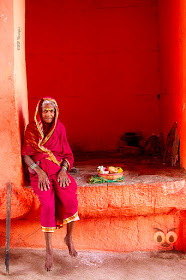The Mahamaye temple is enveloped in a maze of streets in the small town of Kuknoor in Koppal district of Karnataka. Its historical significance dates back to the times of Mahabharata and has quite an interesting tale to tell. The temple by itself is fully functional with throngs of devotees descending upon the temple on a daily basis.
 |
| There was something captivating about her as she sat there and offered 'kumkum' and 'haldi'. |
As we entered we saw a dear old woman sitting in one side of the entrance. She was offering 'kumkum' and 'haldi' to the devotees, in exchange for whatever amount of money they decided to drop into her plate. She was really determined in her efforts too. Despite her frail appearance, it was impossible to bypass her and walk straight into the temple. She looked radiant in a red sari almost blending into the orange red color of the walls. When I asked her permission to click her pic, she readily obliged. I wanted to click candidly but she was more of a pro and even smoothened out her sari and struck a sweet pose. How could anyone ignore that?
 |
| Mahamaye temple |
This temple is dated back to around the 8th or 9th century. Kuknoor at that time was of utmost significance to the Rashtrakoota and Chalukya dynasties.
As we wandered into the temple trying to get to know more about the temple's significance, one of the priests unwittingly came forward to guide us. I am sure he would not have been prepared for the question paper we had ready for him.
 |
| The inscription panel |
He led us to a huge inscription stone that was parked away in a pretty much dark corner of the temple. The only way we could get any image of it was with lights from our phones. Old oil cans stood at its base and used cloth bundles seemed to be stuffed behind and around it. Old was definitely not gold here! Of course the faded out lettering and the ancient dialect was not for us to decipher, but we did learn about the power of the temple.
 |
| A view of the main sanctum in the Mahamaye temple. |
The name Mahamaye is derived from the 2 powerful goddesses in Hindu culture, Lakshmi and Parvati, who are the residing deities in the temple. Shiva and Vishnu combine to form another powerful deity, Harihara. It is considered to be all the more powerful because of the south facing deities.
 |
| An upgraded granite shrine for the deity |
Though this temple has such incredible power and significance, we once again noticed that the main sanctum sanctorum had been modified and upgraded with granite and tiles, leaving little to no indication of the original beauty this magnificent temple would have had.
The priest, who was trying to be helpful, seemed to get a bit confused by all our further barrage of questions. So we had to leave him alone, much to his relief, and get our answers elsewhere.
Coming to the Mahabharata connection of the temple, a Kali temple is said to exist below the Mahamaye temple. This Kali temple is said to be the place where King Chandrahasa is said to have sacrificed himself in order to appease goddess Kali and restore the lives of his father-in-law Dushtabudhi and brother-in-law Madana. After this sacrifice, goddess Kali is said to have brought all the three back to life. Ironically it was Dushtabudhi who had made multiple attempts on Chandrahasa's life earlier and Madana was killed by mistake during one such attempt. A grief stricken Dushtabudhi had taken his own life on seeing that his son was killed instead of Chandrahasa.
When Yudishtira performed the Ashwamedha Yajna, King Chandrahasa accompanied Arjuna and his army to follow the ceremonial horse on its journey, in the quest of conquering other kingdoms.
This Kali temple is also supposed to have been a place for human sacrifices. The temple was then buried below the earth. The evil spirits that were in the temple were also contained and bound within the earth with the help of powerful mantras to form a spiritual barrier and keep them from escaping.
In fact the fear of these spirits is so high that an attempt to excavate the Kali temple some years ago was thwarted by the locals as they feared the evil spirits will be released upon their town.
But despite the fear of the evil spirits that lie buried underground, there seems to be no fear of vandalizing the ancient structure above the ground.
I really wondered if the fear of these spirits would somehow keep them from blatantly disfiguring these structures. Or maybe I just watch too many fantasy and science fiction movies, to have such hopes.
Adjacent to the Mahamaye temple is the Navalinga temple and more about it is in the adjacent article. Please do read about it.
Location map:


The forgotten lands. Neglected and lost in the crevices of history.
ReplyDeleteIt is our humble effort to shine spotlight on as many of these treasures of history as possible.
ReplyDeleteBeutiful arrationremnedtheoldstorykeepinformiimguslikethisthanks
ReplyDelete